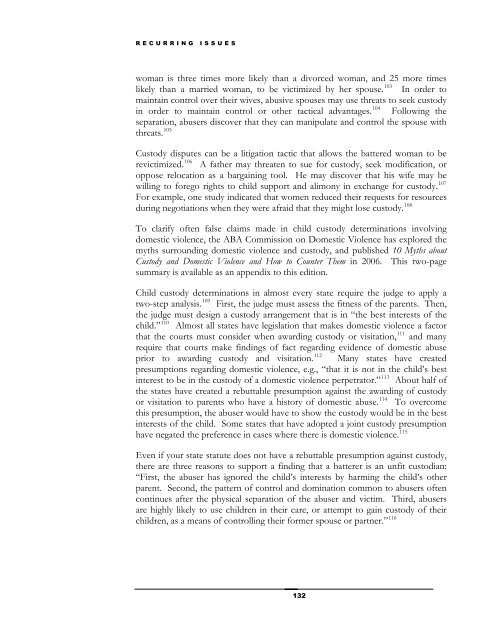A Judge’s Guide
A Judge’s Guide
A Judge’s Guide
You also want an ePaper? Increase the reach of your titles
YUMPU automatically turns print PDFs into web optimized ePapers that Google loves.
RECURRING ISSUES<br />
woman is three times more likely than a divorced woman, and 25 more times<br />
likely than a married woman, to be victimized by her spouse. 103 In order to<br />
maintain control over their wives, abusive spouses may use threats to seek custody<br />
in order to maintain control or other tactical advantages. 104 Following the<br />
separation, abusers discover that they can manipulate and control the spouse with<br />
threats. 105<br />
Custody disputes can be a litigation tactic that allows the battered woman to be<br />
revictimized. 106 A father may threaten to sue for custody, seek modification, or<br />
oppose relocation as a bargaining tool. He may discover that his wife may be<br />
willing to forego rights to child support and alimony in exchange for custody. 107<br />
For example, one study indicated that women reduced their requests for resources<br />
during negotiations when they were afraid that they might lose custody. 108<br />
To clarify often false claims made in child custody determinations involving<br />
domestic violence, the ABA Commission on Domestic Violence has explored the<br />
myths surrounding domestic violence and custody, and published 10 Myths about<br />
Custody and Domestic Violence and How to Counter Them in 2006. This two-page<br />
summary is available as an appendix to this edition.<br />
Child custody determinations in almost every state require the judge to apply a<br />
two-step analysis. 109 First, the judge must assess the fitness of the parents. Then,<br />
the judge must design a custody arrangement that is in “the best interests of the<br />
child.” 110 Almost all states have legislation that makes domestic violence a factor<br />
that the courts must consider when awarding custody or visitation, 111 and many<br />
require that courts make findings of fact regarding evidence of domestic abuse<br />
prior to awarding custody and visitation. 112 Many states have created<br />
presumptions regarding domestic violence, e.g., “that it is not in the child’s best<br />
interest to be in the custody of a domestic violence perpetrator.” 113 About half of<br />
the states have created a rebuttable presumption against the awarding of custody<br />
or visitation to parents who have a history of domestic abuse. 114 To overcome<br />
this presumption, the abuser would have to show the custody would be in the best<br />
interests of the child. Some states that have adopted a joint custody presumption<br />
have negated the preference in cases where there is domestic violence. 115<br />
Even if your state statute does not have a rebuttable presumption against custody,<br />
there are three reasons to support a finding that a batterer is an unfit custodian:<br />
“First, the abuser has ignored the child’s interests by harming the child’s other<br />
parent. Second, the pattern of control and domination common to abusers often<br />
continues after the physical separation of the abuser and victim. Third, abusers<br />
are highly likely to use children in their care, or attempt to gain custody of their<br />
children, as a means of controlling their former spouse or partner.” 116<br />
132 132


